Abstract
There is growing interest in fruit and vegetable cultivation in Japanese agriculture. According to data for 2022, watermelon yield was the highest nationwide at 316kt and the cultivated area was also the highest at 8.94kha. These figures show that watermelon occupies an important position in Japanese agriculture. Additionally, Kumamoto had the largest shipping volume at 45.2kt, indicating that production of certain crops is active in each region. These figures suggest that watermelon cultivation is a growing sector in Japanese agriculture, with the Kumamoto region in particular playing a central role. As demand continues to grow, the production volume and area of fruit vegetables is likely to continue to expand.
Watermelon harvest yield (main data).
Japan’s watermelon harvest peaked at 1.21 Mt in 1973 and has been declining since then. The current harvest is 26.1% of its peak, indicating a continuing downward trend. The reasons for this decline include technological innovation in agriculture and the urbanization of farmland. Other factors that may be contributing include changes in demand and the impact of weather conditions. On the other hand, due to changes in Japan’s agricultural policies and local initiatives, watermelon cultivation is thriving in some areas. In the future, watermelon cultivation may expand again due to changes in demand and technological innovations, but in order to respond to changes in the environment and market, a review of sustainable cultivation methods and market strategies will be necessary.
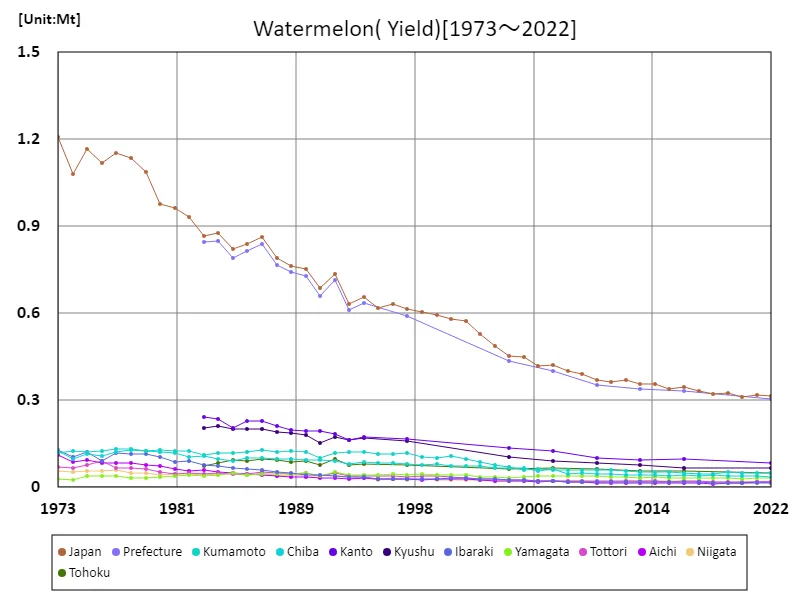

The maximum is 1.21Mt[1973] of Japan, and the current value is about 26.1%
Watermelon harvest volume (by prefecture).
Fruit vegetable harvests in Japanese agriculture are compiled by prefecture, and the latest data for 2022 shows Kumamoto recording the highest overall yield at 48kt. These figures suggest that Kumamoto stands out in the production of fruit vegetables. Generally, fruit vegetable yields are affected by climatic conditions, land use, agricultural techniques, etc., but there are various reasons why Kumamoto leads other regions. For example, Kumamoto has a warm climate, abundant water sources, and advanced agricultural technology. In addition, effective use of local agricultural policies and support systems is also a factor in increasing production. The cultivation of fruit vegetables will continue to grow in importance in various regions, including Kumamoto, and is expected to increase further due to changes in demand and technological innovation. However, from the perspective of environmental protection and sustainable agriculture, measures are needed to address the challenges that come with increased production.
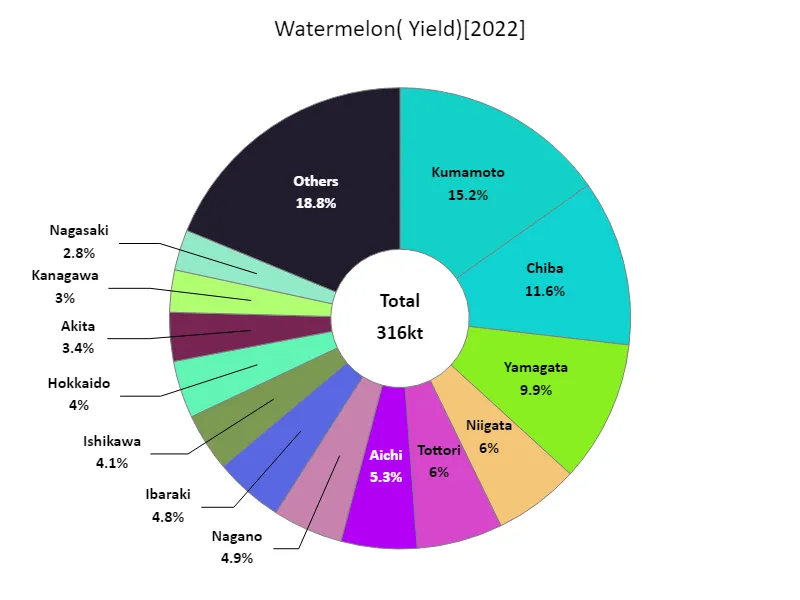

The maximum is 48kt of Kumamoto, the average is 6.72kt, and the total is 316kt
Area cultivated with watermelons (main data).
The area of land cultivated with watermelon in Japanese agriculture peaked at 38.8 kha in 1973 and has since been on a downward trend. The current area under cultivation is 23% of its peak, indicating a continuing decline. The reasons for this decline include structural changes in agriculture and the progress of urbanization. Changes in demand and weather conditions also have an impact on the decline in planted area. On the other hand, thanks to changes in Japan’s agricultural policies and local initiatives, watermelon cultivation is being maintained and expanded in some areas. In the future, changes in demand and technological innovations may lead to an expansion of the area of watermelon cultivation again, but in order to respond to changes in the environment and market, a review of sustainable cultivation methods and market strategies will be necessary.
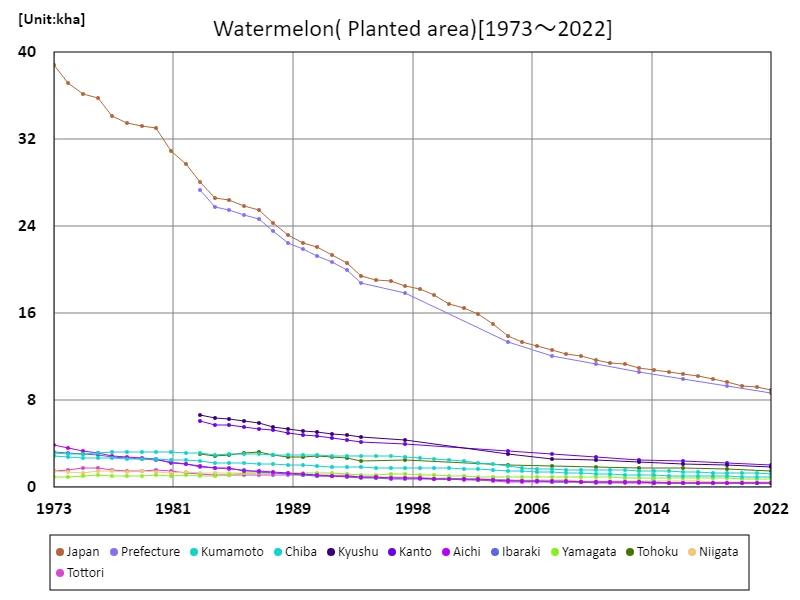

The maximum is 38.8kha[1973] of Japan, and the current value is about 23%
Watermelon cultivation area (by prefecture).
The latest data for 2022 shows that the area of land planted to fruit vegetables in Japanese agriculture is compiled by prefecture, with Kumamoto recording the largest area overall at 1.26kha. These figures suggest that Kumamoto stands out in the cultivation of fruit vegetables. Generally, the area of land planted with fruit vegetables is influenced by climatic conditions, land use, agricultural techniques, etc., but there are various reasons why Kumamoto leads other regions. For example, Kumamoto has a warm climate, abundant water sources, and advanced agricultural technology. In addition, effective use of local agricultural policies and support systems is also a factor in increasing the area under cultivation. The cultivation of fruit vegetables will continue to grow in importance in various regions, including Kumamoto, and is expected to increase further due to changes in demand and technological innovation. However, from the perspective of environmental protection and sustainable agriculture, measures are needed to address the issues that come with increasing cultivated area.
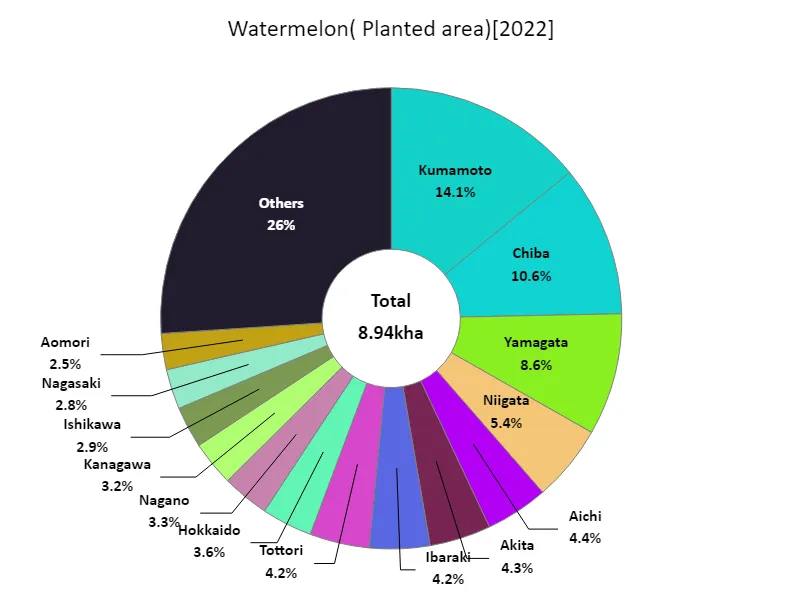

The maximum is 1.26kha of Kumamoto, the average is 190ha, and the total is 8.94kha
Watermelon shipping volume.
According to data for 2022, the volume of watermelon shipped in Japan’s agriculture was highest in Kumamoto at 45.2kt, with an average of 5.83kt and a total of 274kt. These figures suggest that Kumamoto stands out in terms of watermelon shipping volume. Generally, watermelon shipments are influenced by the climatic conditions of the producing area, agricultural techniques, market demand, and other factors, but there are various reasons why Kumamoto leads the way among other regions. Kumamoto’s warm climate, abundant water sources, and advances in agricultural technology are thought to be contributing to the increase in shipping volumes. In addition, effective use of local agricultural policies and support systems is also a factor in increasing shipping volumes. Watermelon shipments are increasing year by year, and further growth is expected in the future due to increased demand and improvements in production technology. However, from the perspective of environmental protection and quality control, the introduction of appropriate management and technology is necessary to ensure sustainable shipping volumes.
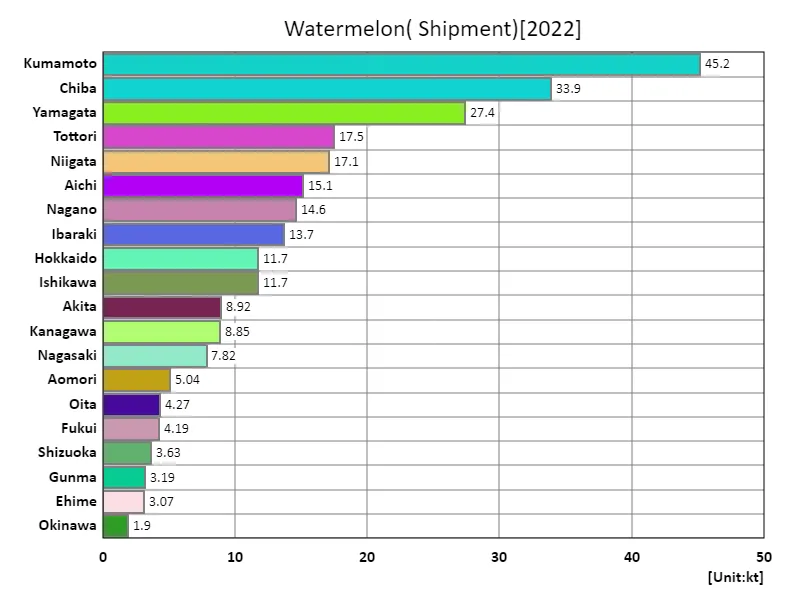

The maximum is 45.2kt of Kumamoto, the average is 5.83kt, and the total is 274kt
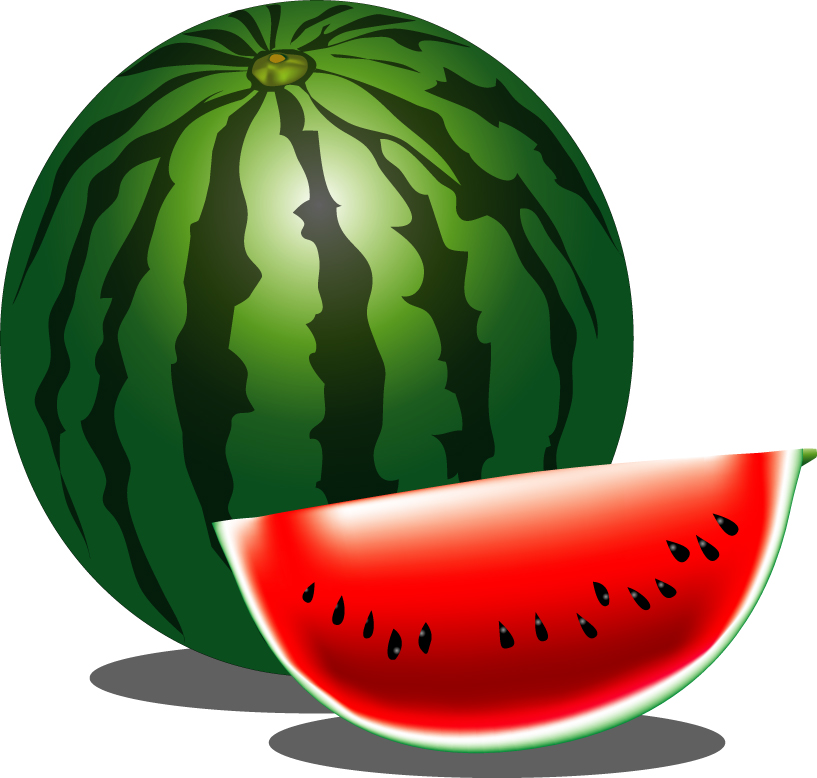


Comments